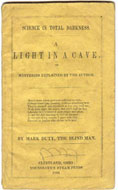|
Mark Duty. A Light in a Cave, or Mysteries Explained by the
Author. Cleveland, Ohio: Younglove’s Steam Press, 1846.
(Science in Total Darkness)
Poem on cover:
Here’s three dozen problems unfolded to view,
Perhaps something pleasing, perhaps something new;
They’re showed and explained as you may well see;
With care, sight the pages, and you’ll find the key.
Likewise, here’s inserted quite simple and plain,
A cure for dull thinking as well as for pain;
At the end of my treatise I place a receipt,
Directed to Ladies who choose to be neat.
This small pamphlet published in Cleveland in 1846 opens with the
poignant statement:
“The Author of this little book has been totally blind for
fourteen years, and during that time, has spent all the means in
his possession, and all he could obtain from his friends, in attempting
to regain his sight.”
 The
author, Mark Duty, goes on to describe himself as 67 years old and
now resigned to his fate of being sightless. He had studied mathematics
for some years, and sought to support himself by publishing this
book of explanations on how to solve everyday mathematical problems
involving building fences, sawing boards, and buying livestock.
There follows a “certificate” signed by Joseph R. Cook
of Ashtabula County, and William Phillips and Hiram M. Addison of
Cuyahoga County, verifying that they wrote down the explanations
of the author as dictated to them. The
author, Mark Duty, goes on to describe himself as 67 years old and
now resigned to his fate of being sightless. He had studied mathematics
for some years, and sought to support himself by publishing this
book of explanations on how to solve everyday mathematical problems
involving building fences, sawing boards, and buying livestock.
There follows a “certificate” signed by Joseph R. Cook
of Ashtabula County, and William Phillips and Hiram M. Addison of
Cuyahoga County, verifying that they wrote down the explanations
of the author as dictated to them.
There are three poems and four recipes (or “receipts”)
at the end of the book, including one for the ladies (as promised
in the opening poem) for “easy and clean washing” which
contains soap, sal soda (washing soda), and spirits of turpentine.
The back cover prints a “teaser” problem, with the solution
offered upon payment of 25 cents. Only three copies of this book
are known to be extant.
Mark Duty was father-in-law to Platt R. Spencer, “the father
of penmanship” and founder of the “Spencerian system,”
whose books on the subject began to appear two years later, in 1848,
published in his hometown of Geneva, Ohio.
|